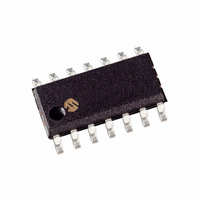PIC16F506-I/SL Microchip Technology, PIC16F506-I/SL Datasheet - Page 11

PIC16F506-I/SL
Manufacturer Part Number
PIC16F506-I/SL
Description
IC PIC MCU FLASH 1KX14 14SOIC
Manufacturer
Microchip Technology
Series
PIC® 16Fr
Datasheets
1.PIC12F510-ISN.pdf
(124 pages)
2.PIC16F506-ISL.pdf
(12 pages)
3.PIC16F506-ISL.pdf
(8 pages)
4.PIC16F506-ISL.pdf
(22 pages)
5.PIC16F506-IP.pdf
(114 pages)
Specifications of PIC16F506-I/SL
Program Memory Type
FLASH
Program Memory Size
1.5KB (1K x 12)
Package / Case
14-SOIC (3.9mm Width), 14-SOL
Core Processor
PIC
Core Size
8-Bit
Speed
20MHz
Peripherals
POR, WDT
Number Of I /o
11
Ram Size
67 x 8
Voltage - Supply (vcc/vdd)
2 V ~ 5.5 V
Data Converters
A/D 4x8b
Oscillator Type
Internal
Operating Temperature
-40°C ~ 85°C
Processor Series
PIC16F
Core
PIC
Data Bus Width
8 bit
Data Ram Size
67 B
Maximum Clock Frequency
20 MHz
Number Of Programmable I/os
12
Number Of Timers
1
Maximum Operating Temperature
+ 85 C
Mounting Style
SMD/SMT
3rd Party Development Tools
52715-96, 52716-328, 52717-734
Development Tools By Supplier
PG164130, DV164035, DV244005, DV164005, PG164120, ICE2000
Minimum Operating Temperature
- 40 C
On-chip Adc
3-ch x 8-bit
Lead Free Status / RoHS Status
Lead free / RoHS Compliant
Eeprom Size
-
Connectivity
-
Lead Free Status / Rohs Status
Lead free / RoHS Compliant
Available stocks
Company
Part Number
Manufacturer
Quantity
Price
Company:
Part Number:
PIC16F506-I/SL
Manufacturer:
MICROCHIP
Quantity:
16 700
Company:
Part Number:
PIC16F506-I/SL
Manufacturer:
Microchip Technology
Quantity:
33 360
Part Number:
PIC16F506-I/SL
Manufacturer:
MICROCHIP/微芯
Quantity:
20 000
3.0
The high performance of the PIC12F510/16F506
devices can be attributed to a number of architectural
features commonly found in RISC microprocessors.
The PIC12F510/16F506 devices use a Harvard archi-
tecture in which program and data are accessed on
separate buses. This improves bandwidth over tradi-
tional von Neumann architectures where program and
data are fetched on the same bus. Separating program
and data memory further allows instructions to be sized
differently than the 8-bit wide data word. Instruction
opcodes are 12 bits wide, making it possible to have all
single-word instructions. A 12-bit wide program mem-
ory access bus fetches a 12-bit instruction in a single
cycle. A two-stage pipeline overlaps fetch and execu-
tion of instructions. Consequently, all instructions (33)
execute in a single cycle (200 ns @ 20 MHz, 1 μs @
4 MHz) except for program branches.
Table 3-1 lists program memory (Flash) and data
memory (RAM) for the PIC12F510/16F506 devices.
TABLE 3-1:
The PIC12F510/16F506 devices can directly or indi-
rectly address its register files and data memory. All
Special Function Registers (SFRs), including the PC,
are mapped in the data memory. The PIC12F510/
16F506 devices have a highly orthogonal (symmetri-
cal) instruction set that makes it possible to carry out
any operation, on any register, using any addressing
mode. This symmetrical nature and lack of “special
optimal situations” make programming with the
PIC12F510/16F506 devices simple, yet efficient. In
addition, the learning curve is reduced significantly.
The PIC12F510/16F506 devices contain an 8-bit ALU
and working register. The ALU is a general purpose
arithmetic unit. It performs arithmetic and Boolean
functions between data in the working register and any
register file.
© 2007 Microchip Technology Inc.
PIC12F510
PIC16F506
Device
ARCHITECTURAL OVERVIEW
PIC12F510/16F506 MEMORY
1024 x 12
1024 x 12
Program
Memory
38 x 8
67 x 8
Data
The ALU is 8 bits wide and capable of addition, subtrac-
tion, shift and logical operations. Unless otherwise
mentioned, arithmetic operations are two’s comple-
ment in nature. In two-operand instructions, one
operand is typically the W (working) register. The other
operand is either a file register or an immediate
constant. In single-operand instructions, the operand is
either the W register or a file register.
The W register is an 8-bit working register used for ALU
operations. It is not an addressable register.
Depending on the instruction executed, the ALU may
affect the values of the Carry (C), Digit Carry (DC) and
Zero (Z) bits in the STATUS register. The C and DC bits
operate as a borrow and digit borrow out bit, respec-
tively, in subtraction. See the SUBWF and ADDWF
instructions for examples.
A simplified block diagram is shown in Figure 3-1 for
PIC12F510 with the corresponding device pins
described in Table 3-2. A simplified block diagram for
PIC16F506
corresponding device pins described in Table 3-3.
PIC12F510/16F506
is
shown
in
Figure 3-2
DS41268D-page 9
with
the


















